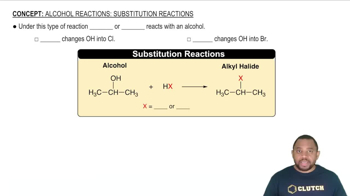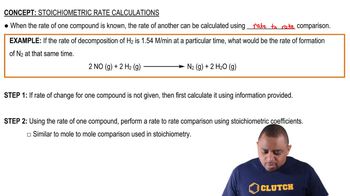Here are the essential concepts you must grasp in order to answer the question correctly.
Equilibrium Constant (Kc)
The equilibrium constant, Kc, quantifies the ratio of the concentrations of products to reactants at equilibrium for a reversible reaction. In this case, Kc = [CH3OH][Cl-] / [CH3Cl][OH-]. A large Kc value, such as 1 * 10^16, indicates that at equilibrium, the products are favored, suggesting that the reaction proceeds almost to completion.
Recommended video:
Equilibrium Constant Expressions
Substitution Reaction
A substitution reaction involves the replacement of one functional group in a molecule with another. In this scenario, chloromethane (CH3Cl) undergoes nucleophilic substitution where the chloride ion (Cl-) is replaced by the hydroxide ion (OH-), resulting in the formation of methanol (CH3OH). Understanding this mechanism is crucial for predicting the products and the direction of the reaction.
Recommended video:
Alcohol Reactions: Substitution Reactions
Stoichiometry and Concentration Calculations
Stoichiometry involves the calculation of reactants and products in chemical reactions based on their molar ratios. In this problem, the initial concentrations of CH3Cl and NaOH must be considered to determine the changes in concentration as the reaction proceeds. By assuming the reaction goes to completion and then accounting for the reverse reaction, one can calculate the equilibrium concentrations of all species involved.
Recommended video:
Stoichiometric Rate Calculations
 Verified step by step guidance
Verified step by step guidance

